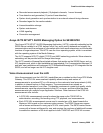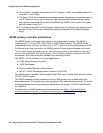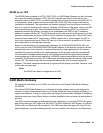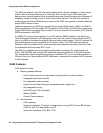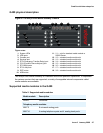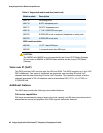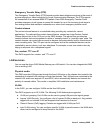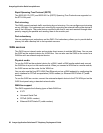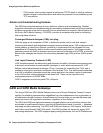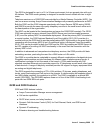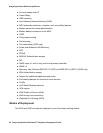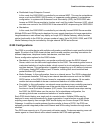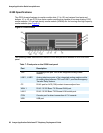
Small to mid-size enterprise
Issue 6 January 2008 49
Emergency Transfer Relay (ETR)
The Emergency Transfer Relay (ETR) feature provides basic telephone services in the event of
a power outage or a failed connection to Avaya Communication Manager. The ETR supports
the connection of two external 808A ETR panels. Each 808A Emergency Transfer Panel
provides emergency trunk bypass or power-fail transfer for up to five incoming trunk loops to
five analog phones and maintains connections on return from emergency transfer mode.
Contact closure
The contact closure feature is a controllable relay providing dry contacts for various
applications. To implement the contact closure feature, connect an Avaya Partner Contact
Closure Adjunct box to the CCA port on the G450 chassis. The adjunct box provides two
contact closures that can be operated in either a “normally closed” or “normally open” state. The
contact closures can control devices such as devices that automatically lock or unlock doors or
voice recording units. The CCA port can be configured so that the connected devices can be
controlled by an end device, such as a telephone. For example, a user can unlock a door by
keying a sequence into a telephone keypad.
Fax, modem, TTY over IP
The G450 supports fax, modem, and TTY over IP.
LAN services
You can use the Avaya G450 Media Gateway as a LAN switch. You can also integrate the G450
into an existing LAN.
Physical media
The G450 provides LAN services through the fixed LAN ports on the chassis front panel for the
connection of external LAN switches or local data devices. The LAN ports are connected to the
internal LAN switch and support HP auto-MDIX, which automatically detects and corrects the
polarity of crossed cables. This results in simplified LAN installation and maintenance.
VLANs
In the G450, you can configure VLANs on the fixed LAN ports.
The G450 supports up to 64 VLANs. The following VLAN features are supported:
● VLAN port grouping. Port VLANs can be used to group LAN ports into logical groups.
● Ingress VLAN Security. You configure a list of ingress VLANs on each port. Any packets
tagged with an unlisted VLAN are dropped when received on the port.
● Class of Service (CoS) tagging. Packets are tagged with VLANs per CoS.
● Inter-VLAN routing. You can configure specific VLANs to permit access to the WAN while
others can be configured to deny access to the WAN.



